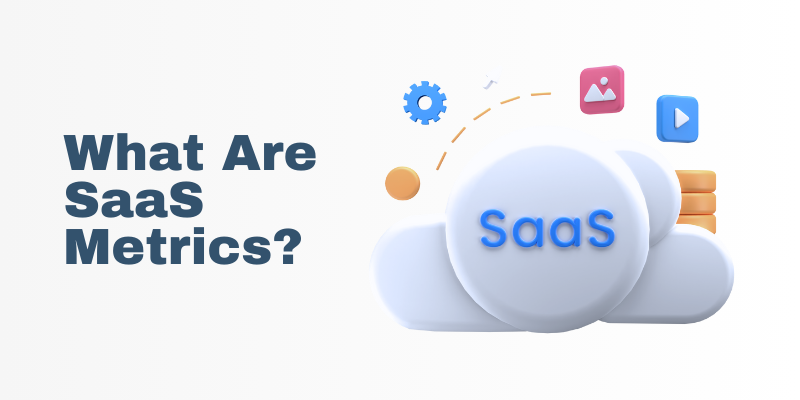Introduction
The global SaaS market is expected to exceed $900 billion by 2030, up from $237.48 billion in 2022.
It’s crucial for your SaaS company to track the right metrics to make informed decisions and achieve long-term growth, regardless of your data expertise. Here are seventeen crucial SaaS metrics to monitor.
What are SaaS Metrics?

The vital signs that assist you in monitoring the expansion, prosperity, and well-being of a software as a service (SaaS) enterprise are SaaS metrics. These indicators, which range from customer acquisition cost (CAC) to customer lifetime value (LTV), can help you attract investors and provide you with information about what’s happening in product development, marketing, sales and customer success.
These measurements offer priceless insights into many facets of the performance and well-being of the company.
How many metrics exist for SaaS?
Nowadays, businesses monitor their performance using a wide range of SaaS metrics and variants. We’ll highlight the top 17, but constant monitoring of all is vital for your company’s health.
Also read : Customer Retention Strategies for SaaS Product
So without more delay, let’s get going.
17 Key SaaS Metrics

It might be challenging to determine how your SaaS business is doing. It’s possible that you’re receiving a lot of leads but no conversions. The following SaaS metrics will reveal to you the true image of your company and how you can improve it.
1. Lead to Rate of Customers
Getting leads to become customers is the ultimate aim of any SaaS company. You convert leads into customers at a high rate, demonstrating your ability to generate sales-ready leads.
2. Value of a Customer Lifetime
The customer lifetime value (CLTV), one of the most often used SaaS metrics, indicates the total amount of money your company anticipates earning from a client throughout the course of that account. The lifetime value increases as a consumer uses your product for a longer period of time.
3. Improving planning and strategy
Allocating resources and doing strategic planning are made easier with an understanding of key indicators of performance (KPIs). SaaS analytics help entrepreneurs choose which areas to allocate money for with the greatest impact and how effective their tactics are.
4. Cost of Customer Acquisition
It looks like you’re gaining a lot of new clients. The client acquisition cost, or CAC, gauges the true cost to my company for each new customer.
5. Ratio of LTV to CAC
This implies that you will not be profitable even if your monthly income continues to rise annually. To calculate that, you can use an LTV-to-CAC ratio. It determines a customer’s worth by comparing all of the expenses incurred in acquiring them.
6. Promoting a mindset of ongoing development
The organization regularly monitors and analyes SaaS data to foster a culture of continuous improvement. It motivates groups to continuously look for methods to improve client experiences, streamline processes, and develop.
7. The Customer Engagement Score (CES)
CES goes above and above by tracking consumers’ interactions with your product in addition to whether they check in. The customer engagement score assists you in determining which aspects of your product are successful and where you may need to improve in order to maintain users’ attention.
8. ARPA, or average revenue per account
Average revenue per user (ARPU), or ARPA, is a crucial indicator for determining the average revenue produced per customer account during a certain time frame. It provides information about how your client base affects revenue and helps in spotting upselling and customer growth patterns.
9. Burn several
The burn multiple, calculated by dividing net cash burned by net new ARR over a certain time period, is used to evaluate the sustainability and efficiency of a company’s growth model. Since it places growth in the context of investment, it’s a great addition to growth metrics like NRG.
Burn Multiple: Cash Used / Fresh Annual Recurring Refund
10. Rate of Churn
Churn Rate is the proportion of users who cancel their memberships within a specified period of time. This measure is essential for comprehending client happiness and retention. A high turnover rate may indicate problems with the good or service, whereas a low rate suggests devoted customers.
11. The Gross Margin
The percentage of income left over after deducting costs of goods sold (COGs) or, in the case of a software business, direct costs related to service delivery is known as gross margin. Costs associated with software licensing, server hosting, and direct team costs for customer support and other departments are a few examples of these charges.
12. Time Frame for CAC Payback
The CAC payback period calculates how long it would take you to recover customer acquisition expenditures, which are usually related to sales and marketing. This measure is essential for comprehending the effects on cash flow and the state of the company’s finances, particularly for SaaS companies where large upfront acquisition expenses may apply.
Formula for the CAC Payback Period: CAC ÷ MRR from a new client
13. The NPS, or net promoter score
The Net Promoter Score (NPS) evaluates client loyalty and satisfaction by calculating the probability that they will tell others about the service. It’s a vital sign of consumer attitude and involvement. While low NPS numbers can indicate discontent and the need for adjustments in product or service quality to increase customer experience and loyalty, high NPS values reflect strong customer retention and advocacy.
14. Growth Income
Expansion revenue is a metric used to quantify additional revenue generated from current clients, frequently by way of cross-selling and upselling of extra features or services or higher tier plans. These upsells in a software as a service (SaaS) company could be enhanced functionality, higher usage caps, or premium support services.
15. Active Users Monthly
The Monthly Active Users display the number of unique users who use your program in a particular month. Users on free plans and those on the free trial are primarily excluded from this. This will enable you to follow the customers who purchase your goods but don’t use them. In order to keep these users from leaving your tool, you’ll need to use re-engagement tactics.
16. Rate of Trial Conversion
Customers in SaaS businesses with freemium revenue models, using a free trial, are the ones who quantify a proportionally high number and go on to become paid subscribers, as represented by the Trial Conversion Rate metric. This measure is essential for evaluating how well the trial period persuades customers of the worth of the product. While a lower rate identifies areas for improvement in the trial experience or product features to boost the possibility of users becoming paying customers, a higher rate indicates a successful trial strategy and product-market fit.
Advice on gauging important SaaS metrics
The following data-related best practices need to be kept at the forefront of your mind, regardless of the metrics you employ to monitor a SaaS company’s performance.
Not everything can be measured, therefore you shouldn’t: Your North Star goals, or the most crucial results your company wants to accomplish, should guide what you measure.
You must comprehend the “why” underlying the data: Accurately measuring SaaS metrics is insufficient. In order to identify the underlying causes and motivate change, you must also become inquisitive and intrigued about the reasoning behind the statistics.
Conclusion
Businesses may pinpoint areas for development, enhance their marketing and sales tactics, comprehend consumer behaviour, and make data-driven decisions to boost client acquisition and revenue by keeping an eye on these SaaS indicators. Deliverables Agency is aware of the particular requirements and difficulties faced by startups and small-to-midsize companies. Discover our developer-friendly cloud computing solutions, like Droplets, Kubernetes, and App Platform, together with our straightforward, predictable pricing.
Which books are the best for learning about SaaS metrics?
- Lean Analytics: Using Data to Create a Better Startup Faster
- Customers sucess: How Forward-thinking Businesses are
- Increasing Recurring Revenue and Lowering Churn Lean: the Crucial
- The Essential Guide to SaaS Metrics: How to Expand Your Subscription Company Through Accurate Business Measuring
Can I use every one of these measures right away?
Although it is feasible, it is more productive to concentrate on the indicators that are most pertinent to your SaaS business’s goals and current stage.
How can my SaaS analytics be improved?
Prior to implementing focused measures, such as enhancing user onboarding to increase activation rates or refining marketing tactics to reduce CAC, identify areas of weakness or potential.
SaaS metrics provide a thorough picture of the performance and general health of an organisation. The majority of SaaS companies gauge their level of success based on the number of loyal members and customer retention rate.
What makes SaaS metrics crucial?
SaaS analytics are essential for guiding your company’s course, whether you’re changing course or refining your approach to generating B2B leads.
- Measuring the performance of businesses
- Strengthening planning and strategy
- Boosting customer connections
- Fostering a continuous improvement culture
- crucial SaaS KPIs to keep an eye on







